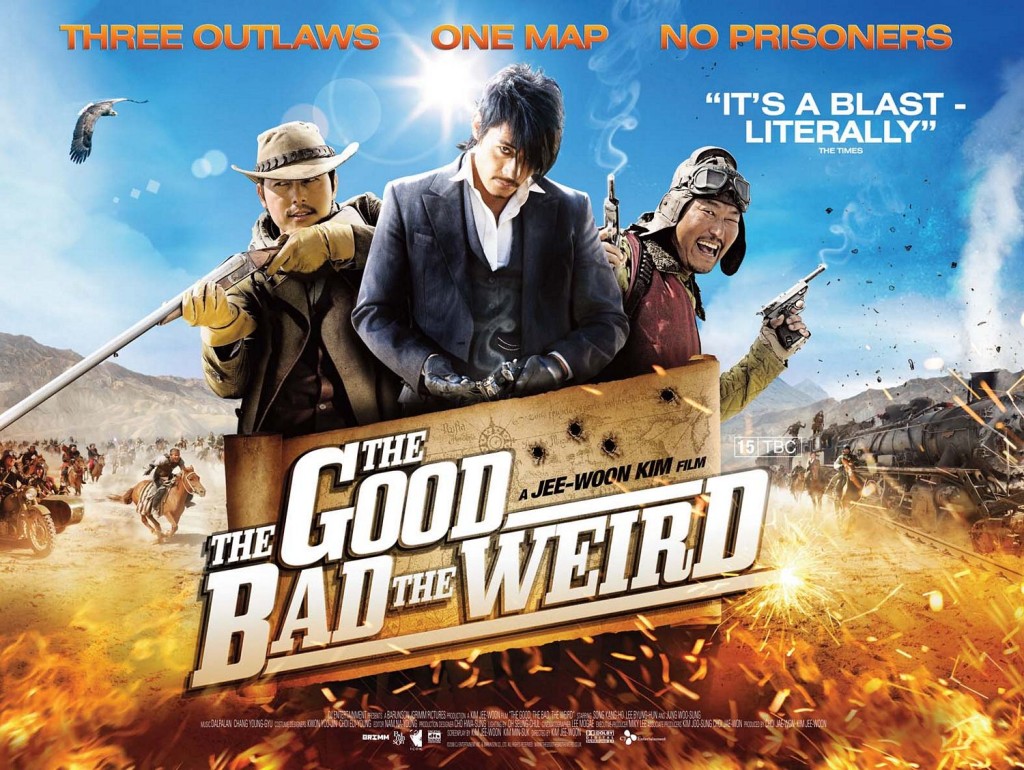Last updated on October 20, 2013
The Good, The Bad, The Weird – So, apparently this is the most expensive (or, at least, was for a time) South Korean film ever made. It shows, even at a relatively light (for Western standards, anyway) ten million dollars. More American Hollywood studios could use some constraints; they’d make more interesting narratives like this rollicking good time.
The Good, The Bad, The Weird (surely this title sounds a lot better and probably rhymes in its native Korean) takes about a thousand cues from Sergio Leone’s Western classic The Good, The Bad, and the Ugly, yet retains its own unique flavor. You know, like the best art it blatantly copies story beats and plot points; the distinction comes all in the telling. Sure, there’s a treasure located somewhere, in Manchuria rather than the Texas Mexican border, and you’ve got three very strange, yet very distinctive archetypal characters (of a sort, don’t quote me on that), but they all strike the viewer with their personality almost immediately.
Yoon Tae-goo, the Weird (played by Kong-ho Song, one of the most famous South Korean actors currently working today) plays a strange bandit with dual pistols and an utterly hilarious, slapstick demeanor. The Good, Park Do-won, played by Woo-sung Jung, gives you that stereotypical strait-laced provider of justice who speaks few words and lets his gun do the talking. However, the Bad, Park Chang-yi, played by Byung-hun Lee, doesn’t take that title lightly; he literally does many, many horrible things and seemingly revels in pain. It’s not as if the film titles them as such, but you’ll be able to place them in their appropriate character slot just from a few seconds on screen. Each of them turns into something more interesting than they were at first glance, and the final “reveals”, so to speak, do a lot to give the story tension on a level beyond treasure and money. I imagine the director Kim Jee-Woon does this intentionally to let the audience make their own decision on the matter.
The cinematography’s crisp and accurate, with none of that foolish shaky-cam so often used in American action films. If there’s one thing I love about Asian cinema in general, the clarity of action must be the first. You can’t get away with bad visual effects or stunts if you show exactly what’s happening, and this film makes zero mistakes in that regard. Heck, I may as well commend the sound design too; everything’s punchy and produces a huge impact appropriate to the context. These aren’t things I wouldn’t bother mentioning, but the whole of the film seems mighty impressive on reflection, so I MUST mention them. I want you to watch it.
To classify this by genre, though, doesn’t do the film justice. More an Indiana Jones-style action-comedy, it also contains a bounty of alternatingly serious and humorous fights with various shootouts attached. Like in the Clint Eastwood favorite, everybody wants the treasure and everyone wants to kill anyone who has it. Replace the Mexican army with the Japanese army (looking for resources during World War II, I think) and the film’s almost a perfect copy…except it’s not. This is much, MUCH more fast-paced and action packed than its inspiration, shoving both character development and action sequences in equal measure within its just-over two hour runtime.
Thankfully, the plot never turns into something too intrusive, but it does explain the motivations of the characters far beyond what you’d expect. In that sense, it’s a great deal like a Sergio Leone film that takes its time with the plot. Sure, the whole affair remains as simple and direct as possible, but it never crosses the line with too much action, too much dialogue, or too much humor. It keeps the audience enthralled, entertained, and (depending on your tolerance for knives) disgusted throughout. Somehow, it crosses cultural barriers too, and I found myself enjoying this film quite a lot.
Now, just to mention the different endings (a possible SPOILER), there’s at least two that I know. The International cut, which I watched, has a decidedly less positive outcome for the climax of the film. The original South Korean cut, on the other hand, ends almost identically to a similar movie mentioned throughout this little piece of text. In that event, I’m not exactly sure which one I want to recommend; the Netflix cut, incidentally, retains the International cut, and the one which the director prefers. In that sense, I like it, but in another sense, it does mean that anyone paying attention to what happened will doubtlessly feel rubbed the wrong way by the lack of an ending rewarding their participation in the subtle sleight-of-hand which occurs towards the end.
Unfortunately, I’m not familiar with any of Kim Jee-Woon’s other films, and thus I cannot comment on whether either ending constitutes something thematically consistent with the rest of his work. On that one, then, you’re on your own. And regardless of which ending you DO see, I recommend at LEAST trying to find the other ending just to see what you missed. It does change the final opinion on the film a little bit, but definitely not its entertainment value. Go watch it in subtitles, because I am absolutely sure with all of my heart that the dub will not capture the nuances of the actors, and that’s a shame for such a good movie. My recommendation on that note looks pretty obvious!
So, would I recommend The Good The Bad The Weird for everyone? Well, considering the fact that it contains lots of violence, both meant for humor and for shock, not really. Think of it as the equivalent of an R-rating, in any event. But, if you’re up for something incredibly different and want for a little adventure, then I say go with this. As said previously, most streaming services will let you watch it with subtitles, so have at it!

